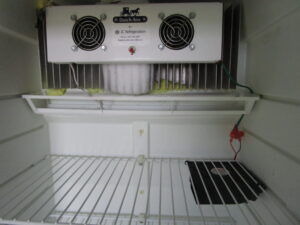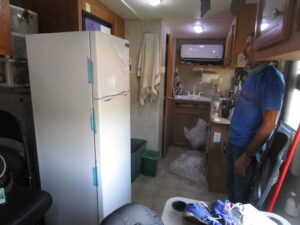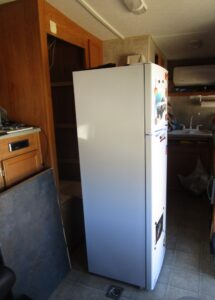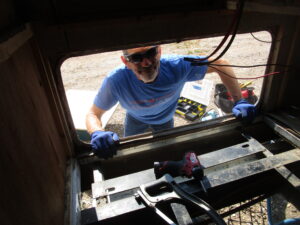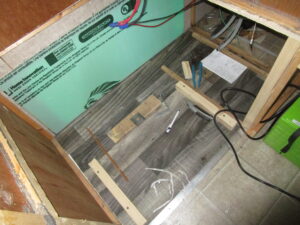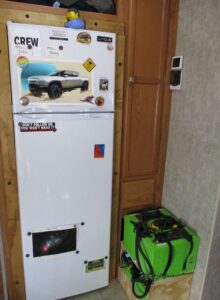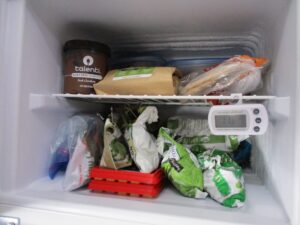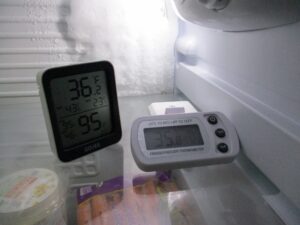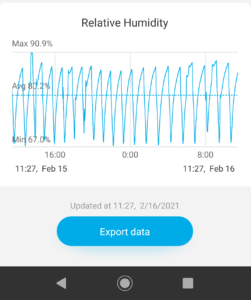I’ve been meaning to write this post for a while, but kinda forgot about it. Our new refrigerator works like any normal appliance is supposed to, and sometimes it doesn’t seem worth mentioning.
However, I’ve got some details about the purchase, installation, and energy usage. It might be useful for anyone considering swapping to a more efficient version.
This is especially applicable if you’re refrigerating partly on propane and would like to reduce/eliminate that hazardous material without using a ton of electricity instead.
Over the summer and fall of 2020, we went 198 days without plugging into shore power and without propane (i.e. living completely off solar power). This was possible partly because of our fridge retrofit and subsequent swap to a new DC version.
The refrigerator evolution:
1. The absorption version that came with Howie in 2006 ran on both propane and electricity; it was nice having flexibility with the fuel source, but it was a real energy hog, especially when running on electricity
Electricity usage (when not running on propane) = ~5-6 kWh per day
2. In September 2019 we did a retrofit on the old fridge to convert it to run on a compressor; thereafter it was electric-only, with much lower energy usage, but it had some problems that I’ll summarize below
Electricity usage = ~0.8 to 1.5 kWh per day
3. We replaced the old fridge with a brand-new DC “solar” version in September 2020; also a compressor (electric-only), even lower energy usage, and it works great
Electricity usage = 0.34 kWh per day (October to January in a chilly winter location; we will monitor this throughout the year to compare)
Once we did the retrofit (stage 2 above), we could have left it in place indefinitely and worked around some of the problems it created.
For example, some of things we ran into:
a) I’ve written about our long saga with the control board freezing up, the addition of an Arduino controller, relay thumping, learning the right way to set up the circuitry, and eventually getting it to work. We had a lot of fun with this, but it isn’t something most people would consider following our lead on.
b) One minor issue we never fixed was the variation in freezer temperature. As outdoor temperatures fluctuated, we adjusted the refrigerator “duty cycle” (the percentage of time it was on vs. off) to keep the fridge temperature in the right range, ideally ~35-38° F (less ideally ~32-40° F). Extra cooling in summertime resulted in a very cold freezer. No big deal. But the reduced cooling in winter meant we had a warm-ish freezer, ~26-32° F. That was not great.
Likely this was due to an insulation problem, especially around the door edges. This appliance was built in 2006 and the seal was probably not holding up. Who knows what other parts were also leaking cold air. So on hot days the fridge ran a lot more than necessary, while on cold days the freezer didn’t stay frozen.
And finally…
c) The thing that caused us to ditch the whole homemade controller project and get a new fridge was a big frost problem that we couldn’t resolve.
Frost built up on the fins and started interfering with the fans. Your refrigerator should never sound like a lawn mower trying to start.
Time to defrost and start over. We tried adding another fan to improve the airflow. After a few weeks, same problem:
JC Refrigeration suggested a couple things to try (including attempting to improve the door seal), but those didn’t pan out. I’m not sure how many times we went through the defrost and restart cycle, no luck:
OK, new fridge it is!
We had said that so many times but each time figured out a workaround. It was a bit hard to believe we were finally giving up for real.
The biggest challenge in a refrigerator replacement in an RV or travel trailer is the size and space consideration. It’s difficult to find an exact copy (standardization, anyone??). Especially since we were venturing away from the standard propane/electricity hog RV version.
It’s easy to end up with a smaller refrigerator and/or less freezer space, and even then it might be hard to work it into the existing space in your home. We decided on one that is slightly thinner and taller. There is a lot more space in the fridge, which makes me very happy after many years of (figuratively) juggling vegetables. We have less space in the freezer, not a perfect solution, not the end of the world.
In order to make this work, John moved the batteries out of the old generator space so he had extra room to play with. The new fridge sits lower than the old one, something I don’t even notice now except that I’ve been looking through the installation photos.
We purchased the new one from Ben’s Discount Supply and even found a “scratch and dent” to save a bit of money. It’s a new appliance, pre-imbued with character in the form of a couple small indentations.
Our model = Unique solar-powered DC fridge (9.0 ft³, compressor), UGP-260L1
The good news is that we can stick magnets on this fridge after so many years of non-metal door covers – that makes me unexpectedly (and probably unreasonably) happy! Magnets are the best collectibles from places we travel, in my opinion.
In addition to the highly desirable “magnets stick to it” feature, the other specs include:
Super efficient construction features 7 cm (2.75”) of insulation in the freezer and 4.5 cm (1.75”) in the fridge
Danfoss/Secop compressor – the world’s leading DC compressor (2 year warranty)
In-line fuse for protection
Thermostat
Adjustable heavy-duty glass shelves
Bottom crisper
Interior LED light
Optional converter to run on AC power, sold separately
Dimensions (H x W x D): 64” x 21.4” x 22.4”
DC Power: 12V/24V
Total Watt Hr. Draw (24V DC): 572 Wh/24 hrs (set to -14°C freezer/ +4°C fridge performance in a +25°C ambient)
Power Consumption: 56 W on 12V/24V
Avg. Run Current: 4.5A on 12V – 2.5A on 24V
Fridge Temp. Range: -4° C to + 10° C
Freezer Temp. Range: -15° C to -6° C
Size: Total: 9.0 cu/ft. / 260 Liters
Weight: 88 lbs. / 40 kg.
We had it delivered to the Fishlake Lumber Company in Beaver, UT (thank you folks for making that easy!). We transported it on its back from there to Howie, so we stood it upright for two days before turning it on.
Welcoming the new arrival – hello, lady:
Side-by-side comparison of new and old:
John wired up 24 volts directly from the batteries and turned it on. It clicked on, started cooling, and controlled the temperature like a normal refrigerator.
That seemed almost too easy!
Here the old one has been removed and the new one already has magnets plastered to the front:
The side-to-side dimensions are similar between the two fridges (with the new one slightly narrower), so that part was easy.
It’s hard to see in the pictures, but the old one sat on a shelf about 21″ off the floor. Underneath this shelf was the generator compartment, which John had converted to a battery storage compartment.
There wasn’t enough overhead space to lift the new fridge onto the shelf without running into the ceiling. John determined that he could move the batteries to a slightly different spot (and since we’re already working on a new, larger set of batteries, he will be redoing that part anyway). He just needed to create a lower platform for the refrigerator to sit on.
Where the old one was resting – we’re going to need a bigger hole:
With renovations already ongoing, why not also fix a couple things in the little closet and get it closer to ready for the eventual new battery installation:
Getting serious with the generator/battery compartment, as seen from inside Howie with the former fridge shelf removed – hi John!
Laying down a new platform:
Yep, it fits! And our current (no pun intended) batteries are “temporarily” living inside:
Surreptitiously taking pictures of John as he installs a nice pretty surface where the new fridge will live:
Bonus – improved insulation in one of the places that most needed it:
The finished result, with side stabilizers, plus a more compact (but still temporary!) battery shelf:
There is so much room in the fridge now, I hardly know what to do with it all. What should we stock up on?
The freezer is more squished, so I plan around that when shopping at Trader Joe’s and Einstein’s on the same day:
There is one minor issue – a small and glacially slow frost build-up. It will need to be defrosted eventually, but I’ve been ignoring it for a while and likely will continue to ignore it for a while more. Not sure why we’re seeing this; at least it’s not interfering with any fans and isn’t growing like a crazy ice monster:
Since we already have several thermometers, we’re still using them:
One new version that I added since the last fridge-related post is from Govee. It includes a Bluetooth connection to my phone and an app that collects data over time. So this is neat (and would be very handy for any temperature or humidity control issues):
In summary:
The refrigerator runs and it keeps food cold. Success! With any luck, this will be the final refrigerator-centric post.
The slow frost buildup will require a defrosting eventually, but at way lower frequency compared to the old version.
We love the low energy usage – it’s barely a blip on our usage charts.
We love the extra fridge space and how quietly it runs.
I kind of miss our Arduino controller. But not really. We’ll find another use for the Arduinos and circuitry.
We probably should have just done this replacement thing in the first place. But then I’d have fewer things to blog about.

